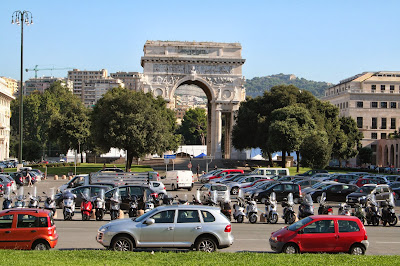In hindsight, I was but a novice in the ways of European
travel in 2010, and several key missteps in planning led to a
longer-than-it-needed-to-be journey from my point of departure in Eugene to my
destination in Genoa (above): a total of 28 hours from end to end.
Eventually finding a bus stop to Genoa outside the terminal, I waited patiently for awhile, but the sun was starting to set and I was no closer to my destination than when I arrived.
Eventually, a kindly Italian taxi driver noticed my plight,
and with a tip o’ the hat to the Rick Steves’ Italian Phrase Book, he informed me that there would be no bus to Genoa, at least on that
day.
Flipping through the book furiously, I learned that I would need to return to the terminal for a motor coach to the main
train station in downtown Milan. Finding the right coach, I settled into my seat at the back of the bus with a sigh of relief.
Then,
we hit the Milan traffic snarl and it took a full 90 minutes to get from the
airport to downtown. I barely made the last train to Genoa. Arriving about midnight, I had lost a full day and a half (counting the nine-hour time
change).This time, we flew through Paris directly into Genoa. After an lengthy layover in the Charles De Gaulle airport (above), we arrived at the Aeroporto Cristoforo Colombo in Genoa (surprisingly small, about the size of Eugene’s). The taxi ride to our hotel was a mere 15 minutes.
Ah, the wonders of hindsight. After a couple days of seeing the city and adjusting to the time change, we took the boat to San Fruttuoso and Portofino. Lots of sailboats and sea craft of all shapes and sizes.
Not surprisingly, Genoa is a hub for shipbuilding, cruise ships, expensive pleasure craft and boats of all kinds. From the top of the hill overlooking Portofino, the waterway traffic was quite busy.
We planned to visit Turin, but missed our train. Instead, we hopped the rails to Ventimiglia (below), a nice alternative. My Milan experience notwithstanding, figuring out “Trenitalia” was relatively easy. By far, the best way to get around Italy is by train.
Our taxi excursion to the hinterlands north of Genoa was the
capper: our good-natured driver Andrea spoke excellent English
and was vital in communicating with townspeople in Orero. A two-hour drive in rural Liguria,
with another hour in Orero, was a bargain at 100 euros.
Flying
back at the end of our tour de Italia, we again flew through Charles De Gaulle,
but instead of a long layover, we barely made it to our gate in time for our
flight to Seattle: quite the opposite of our previous experience. Qu’est sera
sera, whatever will be, will be.











